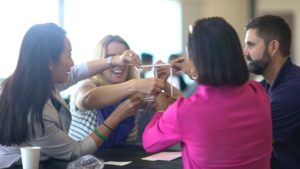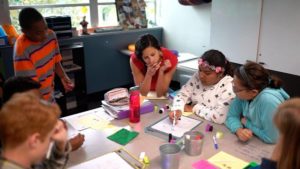This blog was originally posted on June 13, 2017 in Education Week’s Learning Deeply Blog
Four teachers gather around a laptop to watch videos of their students working in groups to solve math problems. Using a protocol to guide their discussion, they pause the videos at opportune moments and practice providing strategic feedback. Their goal: to broaden students’ understanding of what it means to be mathematically smart, and to hone their own skills at recognizing when status issues in group work crop up and how to intervene in the moment.
Adrianna, a 7th grade teacher, hits the spacebar, “There! See how Miguel turned the paper and drew a picture to explain his thinking to his group members? That seemed to help everyone get on the same page.”
“So what would you say to Miguel?” another teacher prompts.
With a mix of awkwardness and sincerity Adrianna addresses the frozen video of Miguel, “Miguel, drawing your representation and turning your paper so everyone could see it has really seemed to help your group come to a common understanding of the problem.”
Adrianna exchanges a satisfied smile with her group and resumes the video, scanning for the next opportunity to make a student aware of how they are behaving like a mathematician, and to celebrate concrete actions students take to support their collective learning.
Adrianna is one of 70 educators from across five districts in Southern California using improvement science to abolish the phrase “I’m just not a math person” and to improve student agency and learning outcomes in math, particularly for students from traditionally marginalized groups. As a networked improvement community (NIC) we are exploring ways to create classroom environments that increase student agency by meeting three overlapping criteria:
- Students feel like they belong and are a valued part of their mathematical community
- Students develop a growth mindset and believe that they can learn the tools of mathematics to explore the world around them
- Students value what they are learning and feel intellectually engaged and challenged
This Mathematical Agency Improvement Community (MAIC) is convened by the Center for Research on Equity and Innovation at the High Tech High Graduate School of Education. School teams come together face-to-face and online to explore “high leverage” evidence-based math practices including group norms and roles, participation quizzes, and strategies for assigning mathematical competence such as using a targeted comment to publicly recognize when a student behaves like a mathematician. During the in-person convenings teachers have an opportunity to experience the practices in action, learn from experts, get into each other’s classrooms, and share challenges and successes from trying the practices in their own contexts.
Current research on how humans learn has underscored the highly neuroplastic nature of the brain and challenged some of our deepest held societal beliefs–that the world is divided into math people and non-math people. In truth, we are constantly creating new neural connections in response to learning experiences, and it is the nature and context of the learning experiences that determine what we learn. This means that everyone has the potential to be a math person; they’ve just been taught that they’re not.
So how can we teach differently? How can we create learning cultures that nurture students’ inherent mathematical curiosity and encourage them to engage deeply with mathematical concepts? And what are we doing that gets in the way?
“So how can we teach differently?”
First, when educators or students view math as a set of procedures to be followed, and equate teaching mathematics with the task of teaching steps to solve a problem, we eliminate opportunities for students to engage in higher order cognitive skills such as problem solving or creating. We effectively do the thinking for them, and many students feel little need to understand the underlying mathematical concept. To combat this issue, MAIC teachers are seeking to shift the traditional teacher-student dynamic in the classroom. Instead of students being the passive recipients of what the teacher understands, MAIC teachers are exploring ways to facilitate whole class discourse and group work so that students have to grapple with problems together and explain their thinking.
A second challenge to increasing student engagement with mathematical concepts is the nature of the task or problem. Tasks that reinforce memorization do little to help students excavate their own assumptions or to build a robust conceptual understanding. Instead, MAIC educators are exploring “discussion worthy” mathematical problems, those that are “low floor and high ceiling” so they provide access and challenge to all learners. Hands-on challenges or visual pattern-based tasks are great examples, as well as tasks that are missing details. Such tasks allow for debate and evaluation of options, and provide opportunities to deepen students’ understanding that real world mathematical problems are often multifaceted, subjective, and rarely have one clear answer.
A third factor that can cause students to shut down and disengage is classroom culture. Is the goal of the class to discuss complex ideas and learn together? Do students feel safe to intellectually explore ideas with their classmates and risk making mistakes? Or do the classroom structures promote speed and competition, celebrating who “gets it” first? If mistakes result in feelings of inadequacy or shame, students’ biggest learning is often not about the math, but a resolve to avoid similar experiences at all costs. Math classrooms that focus on speed and one correct answer can create classroom cultures where deep thinking, risk taking, and creativity are seen by students as a liability. However, if mistakes are celebrated as steps along the path to understanding–and moments when our brains grow–students are more likely to risk making mistakes and embrace similar learning opportunities in the future.
At the heart of this work is shifting students’ own perceptions of whether they and their peers are mathematically “smart” and have something of intellectual value to contribute to the work at hand. For many students (and many adults!), their self-perceptions about whether or not they “are a math person” can take some time to unlearn. And it means finding ways to publicly value behaviors mathematicians engage in every day, but that are rarely celebrated in math classrooms: posing questions, making conjectures, pondering ideas in a systematic way, trying multiple strategies, representing ideas in different ways, identifying patterns, debating, generalizing, taking intellectual risks, and making lots of mistakes.
MAIC teachers’ desire to improve is fueled by the growth they are seeing in their students. As one 8th grade math student reflected at the end of the year:
“I will always remember that first week when we learned about growth mindset and that anyone could be good at math if they just kept doing it. That is something I will remember for the rest of my life. I didn’t know that before your class.”
By using discussion-worthy tasks, encouraging exploration of multiple ways to interpret and solve problems, and publicly recognizing student thinking rather than speed, MAIC teachers are creating the conditions so that all students leave their class believing that they are a math person.
This post is by Daisy Sharrock, education research specialist, Center for Research on Equity and Innovation, High Tech High Graduate School of Education. This post was produced with support from Jobs for the Future’s Student-Centered Learning Research Collaborative and generously funded by the Overdeck Family Foundation and the Nellie Mae Education Foundation.
All images courtesy of Brent Spirnak.

